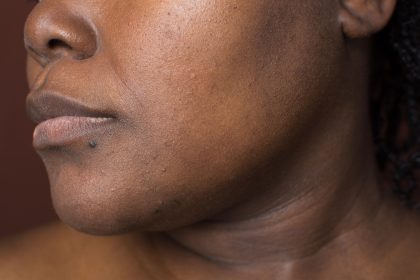You woke up one morning and noticed dark patches creeping across your cheeks like unwelcome visitors who decided to make themselves at home permanently. What started as barely noticeable discoloration has turned into obvious brown or grayish patches that seem to mock every expensive cream and concealer you throw at them. The worst part? They’re not just staying put – they’re spreading and getting darker, turning your face into a frustrating puzzle of uneven skin tone.
If you have darker skin and you’re dealing with melasma, you’re fighting a battle that’s rigged against you from the start. While this condition can affect anyone, it hits women of color like a freight train, creating more severe patches that are harder to treat and more likely to come back with a vengeance. Understanding why your skin reacts so differently to melasma isn’t just about satisfying curiosity – it’s about developing realistic strategies that actually work for your skin type.
The unfortunate truth is that the same genetic factors that give you beautiful, rich skin tone also make you more vulnerable to melasma’s worst effects. Your melanocytes, the cells that produce pigment, are naturally more active and more easily triggered than those in lighter skin. When melasma strikes, it’s like your pigment production goes into overdrive with no off switch.
Your skin cells are programmed to overreact
Think of melanocytes as tiny factories that produce melanin, the pigment that gives your skin its color. In people with darker skin, these factories are naturally running at higher capacity to produce the beautiful pigmentation that protects against sun damage. But when melasma develops, these same factories go completely haywire and start producing way more pigment than they should.
The problem is that melanocytes in darker skin are more sensitive to triggers and tend to stay activated longer once they’ve been stimulated. Even minor triggers that might not cause noticeable changes in lighter skin can create dramatic discoloration in darker skin tones. It’s like having a car alarm that goes off every time a leaf touches the windshield instead of only responding to actual threats.
What makes this even more challenging is that the excess pigment in melasma doesn’t just sit on the surface of your skin where it might be easier to address. In darker skin tones, the melanin often gets deposited deep in the dermis, creating stubborn patches that resist most topical treatments and take much longer to fade than surface-level pigmentation.
Hormones hit your skin like a perfect storm
Estrogen and progesterone, the hormones that fluctuate during pregnancy, while taking birth control pills, or during hormone replacement therapy, act like rocket fuel for melanocyte activity in darker skin. These hormones don’t just gently encourage pigment production, they send your melanocytes into overdrive, creating the dramatic patches that give melasma its nickname as the mask of pregnancy.
Up to 90 percent of people who develop melasma are women, and the condition often makes its first appearance during pregnancy or shortly after starting hormonal birth control. For women with darker skin, this hormonal melasma tends to be more severe and persistent than what lighter-skinned women experience. The patches are typically darker, more extensive, and take much longer to fade even after hormone levels return to normal.
The symmetric pattern that melasma creates across both sides of the face isn’t just cosmetically frustrating – it’s a sign that your entire hormonal system is influencing your skin’s pigment production. When your melanocytes are naturally more active to begin with, hormonal fluctuations can trigger changes that are both more dramatic and more difficult to reverse.
When pregnancy becomes a skin nightmare
Pregnancy melasma in darker skin can be particularly devastating because the hormonal changes are so intense and prolonged. Many women expect their skin to return to normal after delivery, but in darker skin tones, pregnancy-related melasma often persists long after hormones have stabilized. Some women find that their melasma actually gets worse with each subsequent pregnancy, creating cumulative damage that becomes increasingly difficult to manage.
The emotional impact of severe pregnancy melasma shouldn’t be underestimated. At a time when women are already dealing with major physical and emotional changes, having their face dramatically change appearance can be incredibly distressing and affect self-confidence during what should be a joyful time.
Sun protection becomes a full-time job
People with darker skin often underestimate their sun protection needs because they’re less likely to burn than people with lighter skin. But when it comes to melasma, even small amounts of sun exposure can trigger flares or make existing patches dramatically darker. The melanocytes in melasma-affected areas are like hypersensitive security guards, reacting to even minor UV exposure as if it’s a major threat.
The sun protection requirements for managing melasma in darker skin go far beyond preventing sunburn. You need broad-spectrum sunscreen with high SPF applied generously and reapplied every two hours, plus physical protection like wide-brimmed hats and sunglasses. Even indirect sun exposure, like sitting near windows in your car or office, can be enough to trigger melasma flares in sensitive individuals.
What makes this particularly challenging is that many people with darker skin have been told their whole lives that they don’t need as much sun protection. Breaking this mindset and committing to rigorous daily sun protection can feel unnecessary or excessive, but it’s absolutely crucial for melasma management in darker skin tones.
Heat and infrared radiation are secret enemies
Here’s something most people don’t know about melasma in darker skin – heat and infrared radiation can trigger melanocyte activity just as effectively as UV rays. This means that activities like cooking over hot stoves, sitting near fireplaces, using saunas, or even being in very hot, humid environments can potentially worsen melasma.
This heat sensitivity is particularly problematic for women with darker skin because their melanocytes appear to be more responsive to heat-induced stimulation. Some people notice their melasma gets worse during summer months not just because of increased sun exposure, but because of the overall increase in environmental heat that their skin encounters throughout the day.
Treatment becomes a minefield of potential disasters
Treating melasma in darker skin requires walking a tightrope between effectiveness and safety. Many treatments that work well for lighter skin can cause more harm than good in darker skin by triggering post-inflammatory hyperpigmentation or creating light spots that are just as noticeable as the original dark patches.
Aggressive treatments like strong chemical peels, intense pulsed light, or certain laser procedures can backfire spectacularly in darker skin. The skin responds to irritation and inflammation by producing more pigment, which means that treatments intended to lighten melasma can actually make it worse or create additional pigmentation problems.
The most effective approaches for melasma in darker skin are typically gentle, gradual treatments that slowly reduce pigmentation without causing irritation. This might include low-concentration hydroquinone, gentle chemical peels, or prescription medications like tretinoin used at very low strengths and introduced slowly over time.
Finding the right provider is crucial
Not all dermatologists and aestheticians have adequate experience treating melasma in darker skin tones, and this lack of expertise can lead to treatments that are ineffective or actually harmful. Providers who primarily work with lighter skin might not understand how dramatically differently darker skin responds to various treatments.
Some treatments that are commonly recommended for melasma in lighter skin should generally be avoided in darker skin tones unless performed by providers with extensive experience in treating skin of color. The risk of causing permanent hypopigmentation or additional hyperpigmentation is simply too high with many conventional melasma treatments.
Realistic expectations prevent endless frustration
Melasma in darker skin tones rarely disappears completely, and understanding this reality is crucial for developing effective management strategies. The goal is usually significant improvement and prevention of worsening rather than complete elimination of all pigmentation. Setting unrealistic expectations about treatment outcomes often leads to frustration, treatment hopping, and potentially harmful aggressive interventions.
Even with effective treatment, melasma can recur easily if triggers aren’t avoided consistently. This means that sun protection, hormone management, and gentle skincare need to become permanent lifestyle habits rather than temporary measures used only during active treatment periods.
Many people find that their melasma improves significantly during certain seasons or life stages but returns when triggers are reintroduced. Understanding that melasma management is an ongoing process rather than a one-time treatment helps people develop sustainable routines that keep the condition under control over the long term.
Prevention beats treatment every time
For people with darker skin who are at risk for melasma, prevention strategies are often more successful than trying to treat existing pigmentation after it has developed. This means being proactive about sun protection before melasma appears, carefully considering hormonal contraceptive options with your healthcare provider, and using gentle skincare routines that don’t cause inflammation.
If you have a family history of melasma or other risk factors like hormonal changes, starting preventive measures early can significantly reduce your chances of developing severe melasma or minimize its impact if it does appear. This is especially important during high-risk periods like pregnancy or when starting hormonal medications.
Working with dermatologists who have specific experience with melasma in darker skin to develop personalized prevention and management strategies can be one of the most effective approaches to dealing with this challenging condition. The key is understanding that your skin’s unique characteristics require specialized care rather than one-size-fits-all approaches that might work for lighter skin tones but fail for yours.












